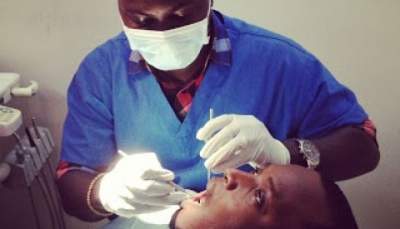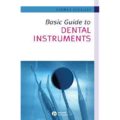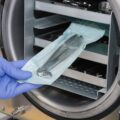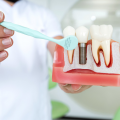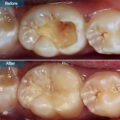According to Wikipedia, Dental instruments are tools that dental professionals use to provide dental treatment. They include tools to examine, manipulate, treat, restore and remove teeth and surrounding oral structures. There are many different dental instruments used by oral health care professionals in their different roles and specialties. Certain types of instruments are unique to various therapeutic procedures. During an examination by a general dentist the following diagnostic instruments may be used:
Cotton pliers: used for placing cotton rolls or plugets to dry up saliva.
Mouth mirror: used to view hard-to-see areas such as the roof of the mouth, behind the molars, and behind the anterior teeth.
Probes: used to measure the depth of periodontal pockets or sulci.
Explorers: used to detect dental caries in tooth grooves and pits.
Dental instruments for Restorative procedures
During restorative treatment the following types of instruments may be used:
Amalgam carriers: for transferring amalgam from the tray to the patient’s mouth.
Burnishers: for smoothing the amalgam filling.
Composite: for use as an alternate filling material when silver fillings are not appealing.
Excavators: for removal of small amounts of decay close to the nerve.
High speed hand piece: for removal of tooth decay. It is commonly known as the drill.
Slow speed hand piece: for removal of deep decay from the teeth. It is commonly known as the slow drill, and is also used in extrinsic stain removal.
Spatulas: for mixing compounds, such as alginate, plaster, dycal, and cements.
Brush holders: for holding tiny brushes and reaching far in to the mouth.
Carvers: for carving the amalgam filling to the shape of the tooth.
Pluggers: for placing amalgam filling deep in the excavated tooth.
Syringes: for washing out excavated teeth with sterile water.
Dental instruments for Periodontal procedures
During periodontal treatment (concerning tissues surrounding the teeth), the following types of instruments may be used:
Gingival knives: small knives used to cut gum tissue in the area of treatment.
Chisels: surgical instruments that aid in the removal of infected bone.
Surgical burs: used in high speed hand drills to aid in the sectioning of the infected bone or roots.
Bone files: surgical instruments that aid in the filing of infected bone in order to remove that portion of infected bone.
Scalers/curets: used for the removal of bacterial toxins and calculus below the gum line.
Dental instruments for Endodontic procedures
During endodontic treatment (concerning diseases of the pulp), the following dental tools may be used:
READ: How much does a tooth filling cost in Nigeria?
Explorers: used to assess the root canals of the tooth.
Spreaders: used to spread the hot gutta percha into the individual root canals.
Files: used to clean out the nerve of the infected tooth. Files come in different lengths and sizes.
Reamers: used to ream out the nerve. Reamers are bigger than a file.
Broach: used to remove hardened nerve tissue (dead nerve tissue) and enlarge the canal.
Syringes: used to flush the canals with sterile water for cleaning.
Dental instruments for Orthodontic procedures
During orthodontic treatment (concerning alignment of teeth), the following instruments may be used:
Cutting instruments: used to cut the wires already placed in the mouth.
Wire forming: used to curve the wire to the correct spree for the individual patient.
Utility plier: used to cut thick wires before placement in the mouth.
Debonding instruments: used to remove molar bands from the molars.
Debanding instruments: used to remove brackets from the teeth.
Ligature forceps: used to place ligature ties around the brackets.
Mosquito forceps: used to place ligature ties around odd angled teeth.
Explorers: used to the remove ligature ties around the brackets.
Dental instruments for Surgical procedures
During surgical procedures heavy-duty steel instruments are needed for leverage and lifting. The instruments are used to remove diseased bone or the roots of teeth. The following instruments may be used:
Elevators: used to raise gum tissue or bone.
Hemostats: used to grasp tissue for removal or retraction.
Root tip picks: used to remove sectioned-off root tips.
Tissue forceps: used to remove or retract tissue.
Bone files: used to file down and remove diseased bone.
Retractors: used to hold the cheeks and tongue out of the way.
Wire cutters and twisters: used to cut wire during wire surgery for better healing of the bone and tissue.
Extraction forceps: used to remove teeth.
Periosteal elevators: used to elevate the periosteal (external to bone) tissue for better viewing of the surgical site.
Scissors: used to cut soft tissue and surgical sutures.
Scalpel: used to incise gum tissue.
Needle holders: used to hold the needle during suturing.
Surgical sutures: made from silk or thread, used to suture tissue together.
Operation
Dental instruments have a variety of applications. Many of the instruments can be used repeatedly after the sterilization process. The life span of the instruments depends on their usage, care, and the method of sterilization. Sterilization prevents the spread of diseases like hepatitis B. Following guidelines set by the ADA and the manufacturer for proper sterilization of non-critical, semi-critical and critical instruments is advised.
Non-critical instruments can be treated with disinfectants classified as high, intermediate, or low relative to their effectiveness against bacterial spores and viruses. Non-critical instruments, such as articulators and spatulas, have no contact with mucous membranes. They do not require sterilization.
Semi-critical instruments touch mucus membranes but do not break the barrier of the mucosal surface or skin. They require sterilization or high-level disinfection, depending on whether they are affected by heat. Sterilization is usually achieved through methods that use extreme heat. Semi-critical instruments include amalgam condensers, hand pieces, and plastic vacuum tips.
Critical instruments require sterilization. These instruments penetrate or touch broken skin or mucus membranes. Critical instruments include needles, scalpels, surgical instruments, dental explorers, dental burs, and endodontic instruments. They must be sterilized.
Endodontic instruments need to be checked daily to determine usability. Files, reamers and broaches become brittle after months of sterilization. The CDCP and ADA recommend critical instruments be cleaned, bagged and then fully sterilized after each procedure. Heavy-duty gloves worn by the dental assistants during cleaning, disinfecting and sterilizing of most dental instruments is advised.
Maintenance of Dental instruments
The ADA recommends that the working parts of all instruments be checked monthly. It is also recommended that a sufficient supply of instruments be maintained in order to allow for proper sterilization. Instruments must be properly taken care of if they are to function as they were intended, for as long as they were intended. A safe and efficient cleaning process will protect the investment you’ve made in high-quality dental instruments.
Some Types Of Dental Instruments

